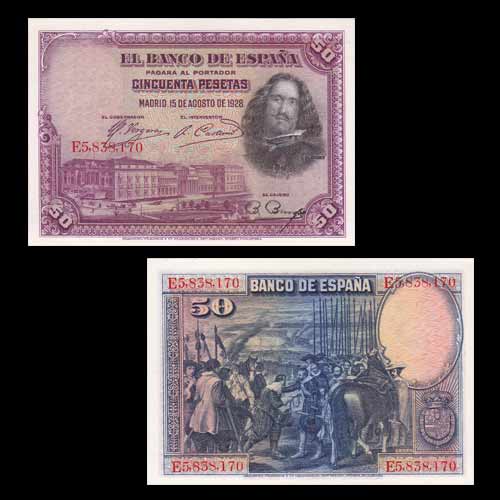History on Banknotes: Part I
2017-12-06 Wed
We have so far just seen our money (banknotes and coins) as legal tenders to be exchanged for availing goods, commodities and services. But have you ever looked at your money as a book, as a source of knowledge and history?We are guessing...No. Well, don’t worry. We will help you gain that vision and give you an insight into a few historical events that were commemorated and immortalised on banknotes!
Today let’s look that a Spanish 50 Pesetas banknote of 1928. The obverse of the note depicts the Prado Museum in Madrid (Museo Nacional del Prado). It also sports portrait of Diego Rodriguez de Silva y Velazquez, a leading artist in the court of King Philip IV. He was one of the most important painters of the Spanish Golden Age and was famous for his numerous renditions of scenes of historical and cultural significance.
Now to the historical part:
The reverse has one of the most notable works of Diego Rodriguez: “The Surrender of Breda”, a rendition of a historical event that took place on June 2, 1625! The Surrender of Breda, also known as El Cuadro de las lanzas or Las lanzas was painted by this great individualistic artist of the contemporary Baroque period during the years 1634–35 on canvas.
The Siege of Breda was one of the major successes of Spanish Army in the latter stages of the Eighty Years' War. Breda was a city near the frontier of Holland occupied in 1567 by the Duke of Alba and later seized by Haultepenne. The Spanish general, Genoese aristocrat Ambrogio Spinola, conquered Breda against the instructions of his superiors.
Diego painted ‘The Surrender of Breda’ as an emblem of Spanish nationalism and as a tribute to Ambrogio Spinola. The painting captures the event that took place on June 2, 1625, when the Dutch governor, Justin de Nassau, delivered the keys of the city, symbolically, to Ambrosio de Spinola.
Interestingly, in 1639, shortly after the canvas was completed, Spain lost the city of Breda forever; it was conquered by Frederick Henry of Orange!
It’s amazing how such events can still be retold through our modern currencies. Stay tuned for more of such historical and cultural insights! Till then...keep visiting!
Latest News
-
Janma Kalnayak of Bhagwan Mahavir
2024-04-24 WedOn 21st April 2024 which was the 2550th Janma Kalnyanak of Bhagwan Mahavir Swami, PM Modi unveile...
-
Gold Pagoda of Vijaynagar Empire King Deva Raya I
2024-04-10 WedKing Deva Raya I of the Vijayanagara Empire was a patron of Kannada literature and architecture. He ...
-
Silver Denarius of Septimus Severus
2024-04-05 FriLucius Septimius Severus served as the Roman emperor from 193 to 211 AD. Severus sat on the throne o...
-
Extremely rare 'Malaharamari' type Gold Gadyana of King Guhalladeva-III Sold for INR 611000
2024-04-03 WedTribhuvanamalla, also known as Guhalladeva III, was the ruler of the Kadamba dynasty. His reign coin...
-
90 Years of RBI
2024-04-02 TueOn 1st April, PM #Modi unveiled a special commemorative coin marking 90 Years since the foundation o...

